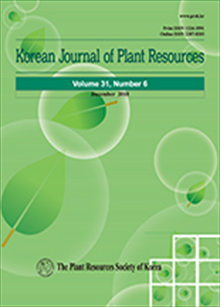간행물
한국자원식물학회지 KCI 등재 Korean journal of plant resources

- 발행기관 한국자원식물학회
- 자료유형 학술지
- 간기 격월간
- ISSN 1226-3591 (Print)2287-8203 (Online)
- 수록기간 1988 ~ 2020
- 주제분류 농수해양 > 농학 농수해양 분류의 다른 간행물
- 십진분류KDC 520DDC 630
권호리스트/논문검색
Vol.11 (1998년 10월) 24건
1.
1998.10
서비스 종료(열람 제한)
2.
1998.10
서비스 종료(열람 제한)
This paper examinies various traditional and alternative practices utilised by Malaysians for the treatment of and preventino against cancer. A list of plants used for treating cancer is given. Care for cancer patients includes food reputed to be good in promoting recovery and preventingrecurrence as well as food taboos-various food to be avoided in the belief that these types of food can induce development or recurrence of cancer.
3.
1998.10
서비스 종료(열람 제한)
When the leaves, roots and stem segments of seedling of Polygonatum odoratum were cultured on Murashige and Skoog medium with 2.0mg/l BAP, stem segments were the most efficient explants for adventitious shoot inductino. To observe the efficient combination of growth regulators on the adventitious shoot formation , stem segments were cultured on MS medium with various kinds of cytokinins (BAP, kinetin, zeatin). From this experiment, cytokinin treatement was prerequisite for theadventitious shoot formatino,especially BAP was the most effective. Auxin (NAA or IBA) in combination with cyotokinin highly enhanced the adventitious shoot formation. Twenty five percents of explants produced the adventitious shoots on medium with 2.0mg/l BAP solely, while 83% of explants produced the adventitious shoots on medium with 2.0mg/l BAP and 0.1mg/l IBA. Root formationform adventitious shoot was promoted after transfer to 1/2 MS medium supplemented with 0.1mg/l IBA and 0.5mg/l zeatin, thereafter the plantlets with shoots and roots were cultured on 1/2MS medium lacking growth regulators. When the stem segments were cultured to MS medium with 1.0mg/l 2,4 NAA and IBA , yellow and nodulous cali were formed from the stem segments which were developed into adventitious roots. These roots were actively grew after transferred to MS liquid medium lacking growth regulators.
4.
1998.10
서비스 종료(열람 제한)
5.
1998.10
서비스 종료(열람 제한)
Many higher fungi were collected at Korea from 1976 to 1998. They were identified and surveyed on resources with many reference books. According to the results, fungal fungi were 40 families, 90 general and 215 species. Among them , anti-cancer resources used in Korea were Ganoderma lucidum, Phellinus linteus, Agaricus brazei and Cordyceps militaris. Three species exception Agaricus brazei were distributed in Korea. All these are cultivated in Korea.
6.
1998.10
서비스 종료(열람 제한)
Liliaceac is one of the largest families fo flowering plants, consisting of about 220-240 genra with 3500-4000 species. According to A. Englcr's classification(1964), it is divided into 13 subfamilies(Table I).
7.
1998.10
서비스 종료(열람 제한)
Screening of new antioxidants form oriental medicines resulted in the isolation of a new antioxidative compound and eight known compounds from the stem bark of Kalopanax pictus. On the basis of various spectrosopic studies, the structure of the new compound was determined to be 4-rhamnose-3,5-dimethoxybenzoic acid methly ester. Other known compounds were identified as ferulic acid, 4,5,6,-trihydroxyflavanone, 2', 4',4' -trihydroxychalcone, caffeic acid, coniferyl alcohol, syringin, 1,3-di-O-caffeoylquinic acid. These compounds showed lipid peroxidation inhibitory acitivity in rat liver microsomes and free radical scavenging acitivity.
8.
1998.10
서비스 종료(열람 제한)
9.
1998.10
서비스 종료(열람 제한)
10.
1998.10
서비스 종료(열람 제한)
11.
1998.10
서비스 종료(열람 제한)
12.
1998.10
서비스 종료(열람 제한)
13.
1998.10
서비스 종료(열람 제한)
14.
1998.10
서비스 종료(열람 제한)
15.
1998.10
서비스 종료(열람 제한)
16.
1998.10
서비스 종료(열람 제한)
17.
1998.10
서비스 종료(열람 제한)
18.
1998.10
서비스 종료(열람 제한)
20.
1998.10
서비스 종료(열람 제한)
1
2

